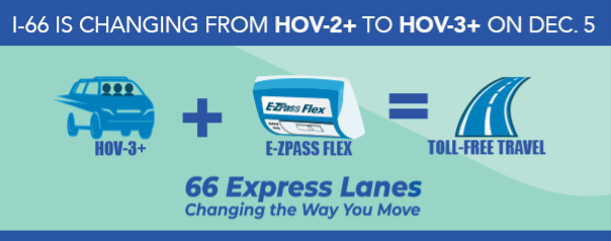
High Occupancy Vehicle (HOV) rules on I-66 have changed as part transforming I-66 to move more people and provide new travel options. As of Dec. 5, 2022, vehicles will need to have three or more occupants to qualify as HOV on I-66 and travel the express lanes without paying a toll. This change from HOV-2+ to HOV-3+ applies across the entire I-66 corridor including the nine miles of 66 Express Lanes located inside the Beltway between I-495 and Route 29 in Rosslyn, which operate on weekdays during peak periods in peak commute directions, as well as the 22.5-miles of 66 Express Lanes located outside the Beltway and the section of I-66 between Haymarket and Gainesville which have HOV rules in place full time.
This HOV change establishes consistent requirements across Northern Virginia’s Express Lanes network on I-66, I-95, I-495, and I-395, providing seamless, reliable travel for carpool, vanpool, and commuter bus travelers. Learn more about this HOV change below.
Incentives for HOV-3+ Carpools VDOT and the region’s Commuter Connections program have partnered to offer an incentive of up to $130 per person for new HOV-3+ carpools traveling in the I-66 corridor. The program is available now and will pay each participant a cash reward following three months of carpooling, regardless of whether they are a driver or passenger and whether it is a new carpool or an existing HOV-2+ carpool adding a third person. Learn more about the Pool Rewards program and sign up here.
VDOT and the region’s Commuter Connections program have partnered to offer an incentive of up to $130 per person for new HOV-3+ carpools traveling in the I-66 corridor. The program is available now and will pay each participant a cash reward following three months of carpooling, regardless of whether they are a driver or passenger and whether it is a new carpool or an existing HOV-2+ carpool adding a third person. Learn more about the Pool Rewards program and sign up here.
Why is HOV Changing on I-66?
Changes to HOV regulations on I-66 have been planned for years as part of the effort to move more people in the I-66 corridor. The change in HOV designation from HOV-2 to HOV-3 on I-66 was approved by the Virginia Commonwealth Transportation Board (CTB) in July 2016. This change supports the public interest by reducing the number of vehicle miles traveled, reducing travel times, increasing speeds in the Express Lanes and general-purpose lanes, and complying with the federal Clean Air Act Amendment of 1990. This HOV-3 policy is consistent with the National Capital Region’s Transportation Planning Board policy since 2010 to increase the occupancy requirements on HOV lanes in the region to HOV-3.
